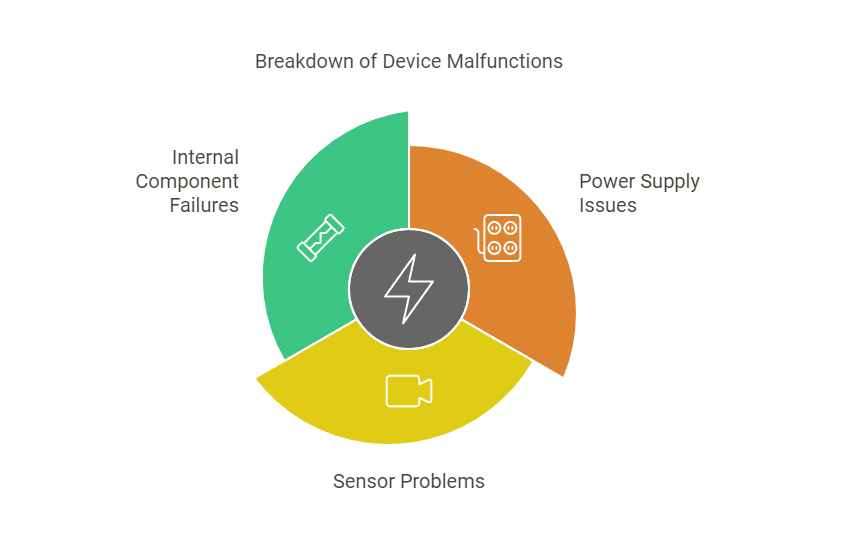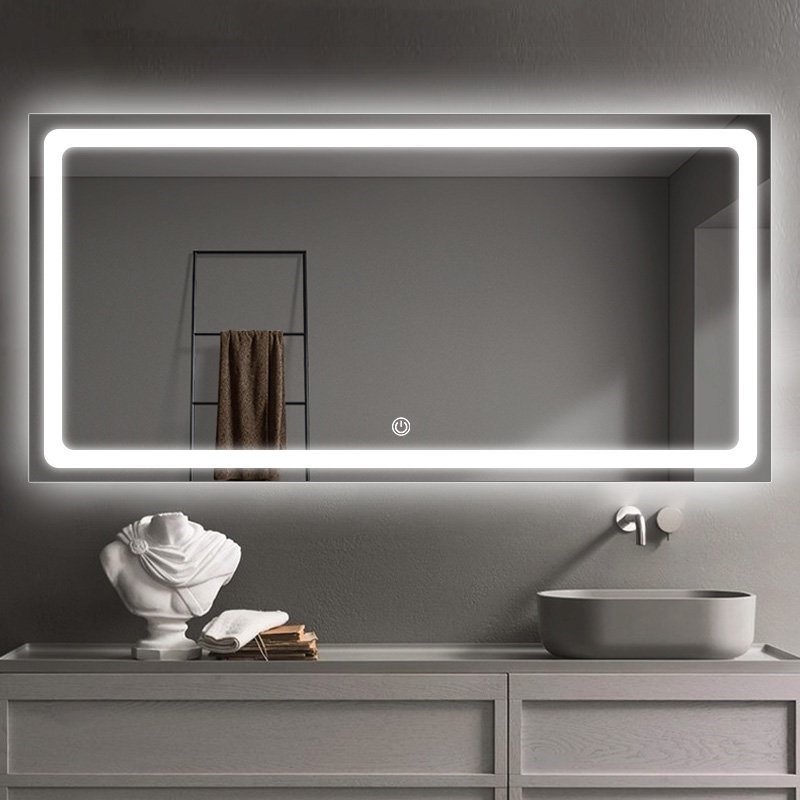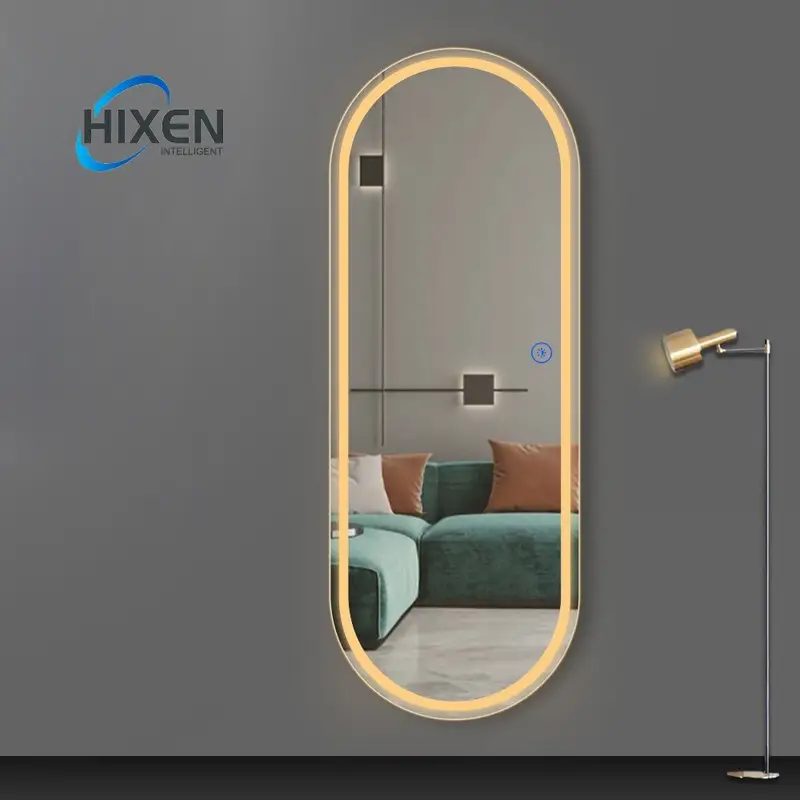|
Conseguir tu Trinidad Audio jugador listo...
|
My led mirror won’t turn on what should I do?
If your led mirror won’t turn on, first check that the power connections and circuit breakers aren’t working properly to make sure the outlet and power cord are okay. Próximo, try replacing the outlet, look at the mirror’s LED components and sensors, then clean them and test their functionality. Check for damaged LED strips or bulbs and consider replacing them. If all these steps don’t solve the problem, you may need professional help to check for installation and wiring issues, as dealing with electrical issues can be risky, so it’s best to seek the assistance of a professional technician if you’re not sure how to proceed.
Before you consider replacing your LED mirror or scheduling an expensive repair service, you should know that many common LED mirror problems have simple solutions you can implement on your own. This comprehensive guide will walk you through the most effective troubleshooting steps and help you understand exactly what may be causing your mirror to malfunction.

Common Reasons Why Your LED Mirror Won’t Turn On
Understanding the root causes of LED mirror failures requires a basic knowledge of how these sophisticated fixtures operate. At their core, LED mirrors combine traditional mirror technology with advanced lighting systems, touch or motion sensors, and various additional features like defoggers or Bluetooth speakers. This complexity means that issues can stem from multiple sources, ranging from simple power problems to more complex electronic malfunctions.
Power supply problems represent the most frequent cause of LED mirror failures. Your mirror’s power system consists of several components working in harmony: the main power cord, an internal transformer that converts standard household voltage to the lower voltage required by LEDs, and various circuit boards that control different functions. When any of these components fail, your mirror might stop working entirely. A thorough examination of your power supply system often reveals issues like loose connections, damaged cords, or faulty transformers that can be addressed without professional help.
Sensor technology, while innovative, can be particularly susceptible to environmental factors. Modern LED mirrors typically employ either capacitive touch sensors or infrared motion detectors, both of which can be affected by moisture, temperature fluctuations, and accumulated debris. The bathroom’s humid environment presents unique challenges for these electronic components, often leading to sensor malfunction or complete failure. Understanding how these sensors work can help you diagnose and resolve issues more effectively.

| Problema | Possible Causes | Solutions |
|---|---|---|
| Touch Sensor Issues | – Moisture buildup – Electronic interference – Component failure | – Dry the mirror and sensor area – Clean with non-abrasive glass cleaner – Hold power button for 10-15 seconds to reset – Check for loose connections behind sensor panel |
| Motion Sensor Malfunctions | – Dirty sensor lens – Incorrect sensitivity settings – Improper placement – Interference from nearby devices | – Clean sensor lens – Adjust sensitivity settings – Ensure proper placement away from heat sources – Check for interference |
| Random Activation Problems | – Environmental triggers (moving curtains, steam) – Incorrect sensor sensitivity – Improper grounding – Electromagnetic interference | – Identify environmental triggers – Adjust sensor sensitivity – Verify grounding – Check for electromagnetic interference |
| Transformer Failure | – Buzzing sound – Incorrect voltage output – Overheating or burning – Mismatched input voltage | – Listen for buzzing sounds – Use un multímetro para verificar la salida de voltaje – Check for signs of overheating or burning – Verify input voltage matches region’s specifications |
| Circuit Connection Issues | – Loose or disconnected wires – Corrosion – Insecure connections | – Inspect for loose or disconnected wires – Check for corrosion – Ensure all connections are secure |
| Moisture Damage | – Water infiltration – Corrosion on circuit boards – Inadequate seals | – Inspect for moisture infiltration points – Look for corrosion – Ensure seals are intact – Allow components to dry completely |
Step-by-Step Troubleshooting Guide
Safety should always be your primary concern when attempting any electrical repairs. Before beginning your troubleshooting journey, ensure you’re working in a dry environment with proper lighting. Unplug your mirror completely from its power source, and gather basic tools like a multimeter, screwdrivers, and cleaning supplies. While LED mirrors operate on low voltage internally, the power supply connects to standard household current, which requires careful handling.
The troubleshooting process should begin with the most basic potential issues before progressing to more complex solutions. Start by examining your mirror’s power connection thoroughly. Many users discover that what appears to be a serious malfunction is simply a loose power cord or a tripped circuit breaker. Test your electrical outlet with another device to confirm it’s providing power, and inspect the entire length of the power cord for any signs of damage, such as fraying or pinching.
Before starting any troubleshooting, ensure your safety:
- Desenchufar el espejo de la fuente de energía
- Keep water away from electrical components
- Work in a well-lit area
- Have basic tools ready (destornillador, multimeter if available)
Start with these basic checks:
- Power Source Verification First, verify your power connection:
- Check if the power cord is firmly plugged into both the mirror and outlet
- Test the outlet with another device
- Inspect the power cord for visible damage
- Check your circuit breaker panel for tripped switches
- Sensor Assessment For mirrors with touch or motion sensors:
- Clean the sensor area with a soft, tela seca
- Remove any objects that might interfere with motion detection
- Look for visible damage to the sensor panel
- Try resetting the mirror by unplugging it for 5 minutos
Advanced Troubleshooting Techniques
The internal components of LED mirrors represent a sophisticated integration of various electronic systems. The transformer, a crucial component often overlooked during basic troubleshooting, converts standard 120V or 240V household current to the 12V or 24V required by LED systems. When investigating transformer issues, you might notice subtle signs of malfunction such as buzzing sounds, which often indicate loose laminations within the transformer core. A properly functioning transformer should operate silently; any noise suggests potential problems requiring attention.
Circuit connections within LED mirrors often face unique challenges due to the bathroom environment. Temperature fluctuations between hot showers and cool periods can cause thermal expansion and contraction of components, potentially loosening connections over time. Además, despite manufacturers’ best efforts at weatherproofing, humidity can penetrate the mirror housing and cause oxidation of circuit board components. A thorough inspection might reveal green or white corrosion on connection points, indicating moisture damage that requires cleaning and possibly resealing of the mirror housing.

Professional Diagnosis and Repair Considerations
When confronted with persistent LED mirror issues, understanding the boundaries between DIY repairs and professional intervention becomes crucial. Modern LED mirrors incorporate sophisticated circuitry that sometimes requires specialized diagnostic equipment. Por ejemplo, smart mirrors with integrated Bluetooth or WiFi capabilities may experience software-related issues that require professional reprogramming. Similarly, mirrors with advanced features like automatic defogging or color temperature adjustment might have multiple circuit boards working in tandem, complicating the diagnostic process.
The decision to repair or replace often depends on factors beyond just the current malfunction. LED technology continues to advance rapidly, with newer models offering improved energy efficiency and additional features. A five-year-old mirror might consume significantly more power than current models, potentially making replacement more cost-effective in the long term. Además, many newer models incorporate improved moisture protection and more reliable touch sensors, addressing common failure points in older units.
Preventive Maintenance and Care
Establishing a regular maintenance routine significantly extends your LED mirror’s lifespan. High-quality LED mirrors typically feature an expected operational life of 50,000 hours or more for the LED components themselves. Sin embargo, this theoretical lifespan assumes proper maintenance and optimal operating conditions. Regular cleaning should go beyond simple surface maintenance – carefully clean sensor areas with appropriate electronic-safe solutions, and inspect seals around the mirror’s edges monthly for any signs of deterioration.
Environmental control plays a crucial role in preventing premature component failure. Modern bathrooms often lack adequate ventilation, creating conditions where humidity levels regularly exceed 80% during and after showers. This high humidity can accelerate corrosion and create conditions favorable for short circuits. Installing a proper ventilation system or running a dehumidifier can significantly reduce these risks. Además, maintaining consistent room temperature helps prevent condensation inside the mirror housing, which can lead to circuit board damage.

Future-Proofing Your LED Mirror Installation
As bathroom technology continues to evolve, considering future-proofing measures during installation or repair becomes increasingly important. Installing a dedicated GFCI circuit for your LED mirror not only improves safety but also provides stable power delivery, reducing the risk of voltage fluctuations that can damage sensitive components. Consider installing a high-quality surge protector designed specifically for bathroom applications to guard against power surges that can damage your mirror’s electronic components.
The integration of smart home technology with LED mirrors presents both opportunities and challenges. If you’re experiencing issues with a smart-enabled mirror, ensure your home’s WiFi network provides adequate coverage in the bathroom area. Signal interference from metal pipes or thick walls can disrupt connectivity, leading to apparent mirror malfunctions that are actually network-related issues.
Preguntas frecuentes
1. Why Isn’t My LED Light Mirror Working?
If your LED mirror light isn’t turning on, several factors could be the cause:
Possible Causes:
- Problemas de la fuente de alimentación: Check if the mirror is correctly plugged in or connected to a power source.
- Blown Fuse or Circuit Breaker: A blown fuse or tripped circuit breaker can cut off power to your mirror.
- Faulty Transformer: LED mirrors require a transformer to convert the power. If the transformer is malfunctioning, your mirror won’t turn on.
Solutions:
- Check Power Source: Ensure the mirror is connected to a functional power supply.
- Reset Circuit Breaker: Inspect the circuit breaker and reset it if necessary.
- Test the Transformer: Use a multimeter to test the transformer’s output. If it’s faulty, you may need a replacement.
2. What to Do If LEDs Won’t Turn On?
If your LED mirror light flickers or doesn’t turn on at all, the issue could lie with the LED bulbs themselves, the sensor, or the wiring.
Possible Causes:
- Burned-out LED Bulbs: LEDs have a long lifespan, but they can still burn out.
- Sensor Issues: Motion sensors or touch sensors can sometimes malfunction, preventing the LEDs from activating.
- Problemas de cableado: Loose or damaged wires can interrupt power supply to the LED bulbs.
Solutions:
- Replace Burned-out LEDs: Inspect the LEDs for signs of burnout and replace them if necessary.
- Check Sensor Functionality: For mirrors with motion or touch sensors, clean the sensor area to ensure it’s not obstructed by dust or moisture. Reset the sensor by holding the power button for 10-15 artículos de segunda clase.
- Inspect the Wiring: If the wiring is loose or damaged, carefully reconnect or replace the wires.
3. Why Is My LED Mirror Sensor Not Working?
LED mirror sensors, whether motion or touch-based, can fail due to various issues like moisture, dirt buildup, or internal component failures.
Possible Causes:
- Moisture Buildup: Excess moisture in the bathroom can interfere with the sensor’s performance.
- Sensor sucio: Dirt and dust can obstruct the sensor, making it unresponsive.
- Component Failure: The sensor’s internal components may have failed over time.
Solutions:
- Dry the Sensor Area: Ensure the sensor and surrounding mirror area are completely dry.
- Clean the Sensor: Gently clean the sensor with a non-abrasive cloth to remove dirt and grime.
- Restablecer el sensor: Perform a reset by holding down the power button for 10-15 artículos de segunda clase.
- Check for Loose Connections: Inspect the wiring connections behind the mirror to ensure they are secure.

4. Why Won’t My Mirror Light Turn On?
When your LED mirror light won’t turn on, the root cause could be linked to power, wiring, or the sensor. Here’s a deeper dive into what could be causing the issue.
Possible Causes:
- Improper Grounding: Improper grounding can cause issues with the mirror’s electrical system.
- Electrical Interference: Nearby electrical appliances may cause interference with the mirror’s functionality.
- Faulty Power Supply: A faulty or incompatible power source can prevent your mirror from lighting up.
Solutions:
- Ensure Proper Grounding: Verify that the mirror is correctly grounded to prevent electrical issues.
- Check for Electrical Interference: Move the mirror away from large electrical appliances that may cause interference.
- Inspect Power Supply: Make sure that the power source provides the correct voltage for the mirror.
5. Common LED Bathroom Mirror Problems and Their Solutions
LED bathroom mirrors are sophisticated, Pero como cualquier tecnología, they come with their own set of common issues. Here are the most frequently encountered problems and practical solutions.
Problema 1: Flickering Lights
- Causas: Loose connections, faulty transformer, or overheating.
- Solución: Tighten connections and ensure the transformer is functioning properly. If the transformer is damaged, replace it.
Problema 2: Motion Sensor Malfunctions
- Causas: Dirt buildup on the sensor lens, interference from nearby objects, or incorrect sensor settings.
- Solución: Clean the sensor lens with a soft cloth and ensure the sensor is positioned correctly away from any obstructions.
Problema 3: Touch Sensor Issues
- Causas: Moisture or dirt on the sensor, electronic interference, or faulty sensor panel.
- Solución: Dry the sensor area, clean with a non-abrasive cleaner, and reset the sensor by holding down the power button for 10-15 artículos de segunda clase.
6. Advanced Troubleshooting for LED Bathroom Mirrors
If you’ve tried basic solutions and your LED mirror still isn’t functioning, here are some advanced troubleshooting tips:
Check the Transformer:
- Listen for buzzing sounds, which indicate transformer failure.
- Use a multimeter to check the transformer’s voltage output.
- If the transformer is faulty, replace it with a new one that matches the required voltage for your mirror.
Inspect the Circuit Connections:
- Remove the mirror’s back panel and look for any loose or disconnected wires.
- Check for signs of corrosion or overheating.
- Tighten any loose connections and replace damaged wires.
Deal with Moisture Damage:
- Inspect for water infiltration points, especially around the edges or seams.
- Check for corrosion on the circuit boards and clean as necessary.
- Allow components to dry completely before testing again..

7. Preventive Maintenance for LED Mirrors
Regular maintenance ensures that your LED mirror continues to work efficiently over time and prevents common issues.
Daily Care:
- Wipe the mirror surface with a soft, dry cloth to keep it clean.
- Keep the sensor area free of dust and moisture.
- Use proper cleaning products designed for mirrors to avoid damage.
Monthly Maintenance:
- Check all visible connections and clean any ventilation areas.
- Test all functions to ensure the mirror is operating as expected.
- Inspect the mirror for signs of wear, corrosion, or damage.
Installation Tips:
- Ensure proper ventilation around the mirror to prevent moisture buildup.
- Install the mirror away from direct water sources, such as showerheads.
- Follow the manufacturer’s installation guidelines for the best results.
Conclusión
Successfully troubleshooting LED mirror issues requires a systematic approach combined with an understanding of the technology involved. While many problems can be resolved through careful DIY diagnosis and repair, knowing when to seek professional assistance is equally important. Regular maintenance and proper installation play crucial roles in preventing future issues and ensuring your LED mirror provides reliable service for years to come.
The future of LED mirror technology continues to evolve, with manufacturers introducing more robust designs and improved features. Whether you’re troubleshooting an existing unit or considering a replacement, understanding these technical aspects helps you make informed decisions about repairs, maintenance, and upgrades.
Need More Help?
Subscribe to our blog for regular updates on LED mirror maintenance, installation best practices, and industry innovations. Our team of experts continuously researches and tests new solutions to common LED mirror issues, sharing insights that help you maintain and optimize your bathroom technology.
Want to learn more about selecting the right LED mirror or finding reliable suppliers? Visit our comprehensive buying guides and supplier recommendations for detailed information about current market offerings and technological advancements in the LED mirror industry.
[Note: This article reflects current industry standards and technical expertise. Always consult your product manual and warranty information for specific guidance regarding your LED mirror model.]
- Explore este enlace para verificar cómo se hacen los espejos.
- Explore este enlace para ver cómo elegir el espejo de baño de tamaño adecuado?
- Para encontrar la parte superior 10 Proveedores de espejo LED Haga clic aquí.
- Para saber cómo arreglar un espejo desilvergido, haga clic aquí.
- Para averiguar cuál es la diferencia entre un espejo costoso y un espejo barato, haga clic aquí.

























